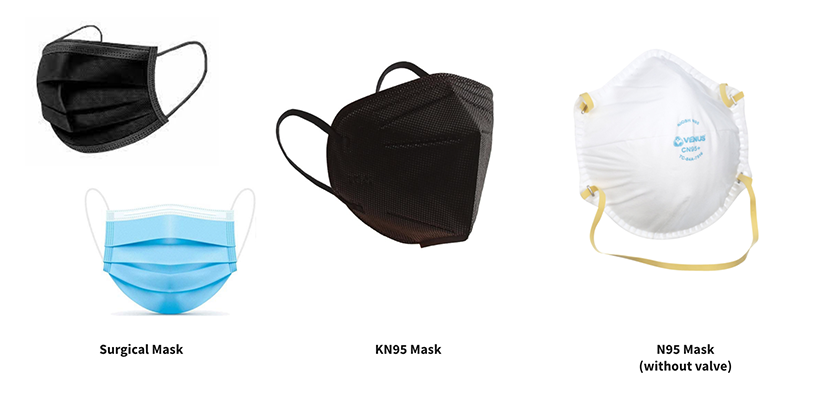Get the Most out of Masking
Effective January 10, 2022, staff, faculty, and students are required to wear a well-fitting surgical mask, KN95, or N95 (without a valve) in indoor campus settings.

Correct and consistent mask use is a critical step everyone can take to prevent getting and spreading COVID-19. This is more important than ever with new, more easily transmitted variants of COVID-19 on the rise. Masks work best when everyone wears them, but not all masks provide the same protection. When choosing a mask, look at how well it fits, how well it filters the air, and how many layers it has.
Two important ways to make sure your mask works the best it can:
- Make sure your mask fits snugly against your face. Gaps can let air with respiratory droplets leak in and out around the edges of the mask.
- Pick a mask with layers to keep your respiratory droplets in and others’ out. A mask with layers will stop more respiratory droplets from getting inside your mask or escaping from your mask if you are sick.
For a complete list of the do’s and don'ts of mask wearing, visit the Centers for Disease Control and Prevention (CDC) website.
Modified University Face Covering Policy
Pepperdine continues to require everyone in the community to wear facial coverings indoors, unless actively eating or drinking or alone in an office. The Los Angeles County Department of Public Health has updated its guidance to require all employees to wear a surgical or KN95/N95 (without a valve) mask. Unless paired with one of the aforementioned types of masks, cloth face coverings for employees are no longer permitted. Pepperdine has updated the University’s face covering policy accordingly.
Additionally, the University’s face covering policy will now require students to wear surgical masks or KN95/N95 masks in all indoor campus settings. This includes, but is not limited to, classrooms, hallways, the HAWC, the Light House, libraries, fitness facilities, and residential hall community spaces. These masks will also be required in residence hall suites, apartments, or individual rooms when guests are present. This mandate will be effective January 10 for at least the next two weeks (through January 21). Cloth masks alone will not be acceptable during this period.

Masks will be available for pick up by faculty, staff, and students at any of the Malibu or graduate campus COVID-19 screening test sites beginning Monday, January 10. Upon showing a Pepperdine ID card, community members will be provided with a weekly supply of medical-grade masks for that particular week. The supply provided will include a combination of surgical and KN95/N95 masks. Employees and students may also use their own upgraded masks.
Choosing your Mask
Know which masks provide the best protection against COVID-19:
| Most Effective | More Effective | Effective | Least Effective |
|---|---|---|---|
|
|
|
|
No matter what kind of mask you wear, check the fit and eliminate gaps above the nose or on the sides. Gaps will significantly reduce the effectiveness of any mask.
N95 Respirators
When they fit well, N95 respirators are highly effective in preventing the spread of COVID-19. Counterfeit N95s can be avoided by making sure they are NIOSH approved and have the required labeling printed directly on the respirator. Choose a size and model that fits your face and has no gaps. Test it by doing a seal check to make sure it fits. If you wear an N95 respirator, you should not wear an additional face covering over or under the respirator, as it can interfere with the seal to the face.
KN95 and KF94 Respirators
KN95s and KF94s are international respirators that are designed to provide good filtration. However, testing of KN95s has shown that some models are not effective. If you do choose to use a KN95, find a KN95 that has been tested by NIOSH and has a minimum "filtration efficiency" of 95% or higher.
Medical Masks (also called Surgical Masks or Disposable Face Masks)
Medical masks include various types of loose-fitting disposable masks. The fit of a medical mask can be improved with a simple modification or by using a mask brace (fitted). Look for the following when buying medical masks:
- Masks with three layers of non-woven material.
- An adjustable nose bridge.
- Surgical masks with ties may provide a closer fit than ear loops.
- Passed ASTM F2100; ASTM F2100 level 2 for higher filtration efficiency (American Society for Testing and Materials).
Cloth Masks
Cloth masks can only work well if they are tight-fitting and made of materials that filter out small particles. Good cloth masks have:
- Two layers of tightly woven cotton with a third layer of non-woven fabric. The third layer could be a mask filter insert or a synthetic fabric such as polypropylene.
- Nose wires to reduce gaps from the nose.
- Adjustable ear loops or straps that go around the head to reduce gaps from the face.
When Wearing an Effective Mask is Especially Important
Some situations require a higher level of protection (improved fit and/or improved filtration):
- In indoor settings with unvaccinated persons or with persons whose vaccination status is unknown.
- In indoor settings with poor ventilation.
- In close quarters with other people where social distancing is not possible (examples: riding a crowded bus, waiting in line at a crowded airport terminal).
- In any public place for people who are older or with medical conditions that put them at higher risk of severe COVID illness.